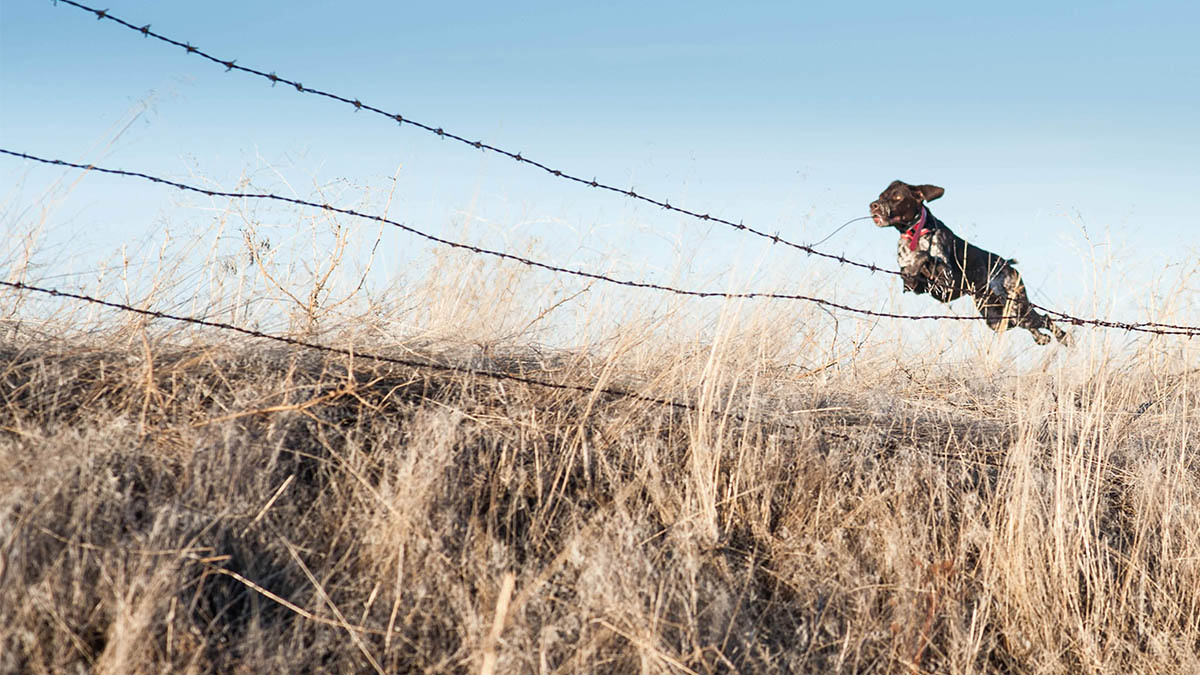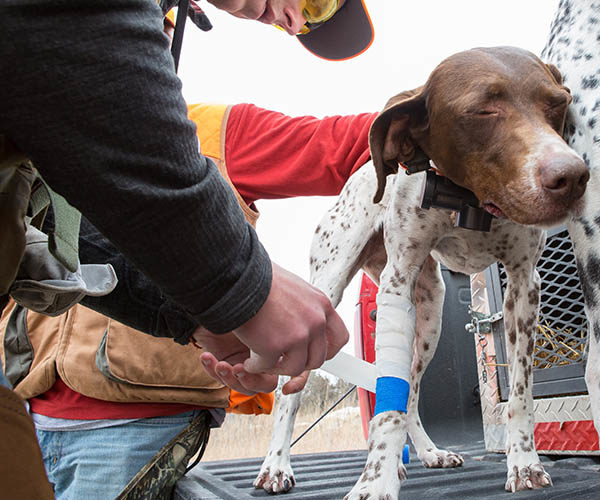
Training and fieldwork creates a special kind of bond between a dog and its owner. But our four-legged friends often find themselves in situations where they need your help. Our new Ask A Vet series delivers advice directly from a professional, working veterinarian. Have a question about your dog? Shoot an email to themeateater@themeateater.com and we’ll dig into the concern.
“I’m on the road a bunch with my two-year-old GWP out West. We constantly encounter lava rock scree fields, barbed wire, and old rusted equipment. Knock on wood, all that my dog has encountered is scrapes so far.
I know the time is going to come when I have to make the decision to deal with a cut or take Ceder in to get stitched up. I’d love to know what to look for and do when that decision comes.” -Matt Hardinge
The most common questions I receive from bird dog owners fall into the same category: “Does this injury require a trip to the vet?” The inquiry is inevitably followed up with a blurry photo of the wound and an implicit hope that I’ll be able to diagnose the issue and send them back out hunting with a home remedy and a clean bill of health.
I admit that I love a good (preferably free) hack that will keep me from opening my wallet and shelling out cash to a professional, especially when it’s something I can handle myself. If you’re too far from a vet or determined to deal with it, at least arm yourself with these few field injury tips.
Wound Severity
If you call our clinic after hours, I’m likely going to ask about the location, size, and depth of the injury. Is it a cut, like a laceration from barbed wire? Or is there a deep puncture that might have been sustained from a collision with a limb? The former may not require veterinary intervention, whereas the latter may look less severe on the surface but may quickly progress to an infection.

The amount of bleeding is relevant in judging the severity (and what owners most often want to tell me about), but in my experience, bird dog owners usually overestimate how much blood is present. Believe me, if the cut has an artery involved, it will be obvious, and you’ll instinctively know to reach out for veterinary help. Regardless of the gruesomeness, if it makes you uncomfortable, have it seen by your vet.
Flush and Clean
Dealing with a wound in a timely manner is critical in minimizing the risk of infection. I keep a squeeze bottle of saline in my vet kit to irrigate dirt and debris. Once most of the contaminants are flushed, I turn to an antiseptic solution. Betadine, chlorhexidine, and hydrogen peroxide all work well to reduce bacterial contamination in most open wounds. Hydrogen peroxide is usually the most readily available, but its use in sterilizing wounds is controversial because it can impact tissue healing long-term. In my opinion, it’s extremely effective at killing bacteria with minimal side effects when used on a fresh wound for a short period of time. Apply liberally to the affected area three times per day until you can have it checked out by a vet or you notice it healing on its own.
Skin Stapler
As useful a tool as they are, a skin stapler alone does not a surgeon make. If you’ve failed to properly clean a wound, closing it with staples only traps in bacteria that will rejoice in the opportunity to reproduce rapidly in the dark, deoxygenated environment you’ve created. When advising bird hunters, I’m more inclined to have them leave the wound open for easier treatment and proper drainage. In all honesty, I’ve seen more issues created by skin staplers than wounds that heal properly with them, but keep in mind that vets often get involved when things go poorly. They’re useful in treating superficial barbed wire cuts of an inch or so, but resist the urge to close a large, contaminated skin flap with a few dozen staples and call it good. You won’t be pleased with the outcome.
Pain and Inflammation
Veterinary-tested and approved anti-inflammatories given at the appropriate dose and interval should always be your first choice for dealing with pain. Most veterinarians reach for carprofen, a dog-friendly cousin to ibuprofen, and we’re often willing to prescribe these prior to the hunting season to use in the event of an injury. If you’re stuck a long way from a veterinarian or it’s after hours, you can get by with aspirin. The dose is roughly 5 to 10 mg per pound orally every 12 hours. There are some flavored over-the-counter formulas for dogs, but just regular human buffered aspirin (325 mg) works well. There can be some side effects of long-term aspirin use, mostly involving the gastrointestinal system, so use it only if there’s no other alternative.
As much as I enjoy helping out fellow bird dog owners, I have to tread lightly in these situations. For one, giving guidance through the phone lines or internet puts me in an awkward position of offering medical advice without actually seeing the patient. It’s sloppy medicine, and if things go wrong, I could be considered liable. Sometimes a scratch is just a scratch, other times what you see on the surface may not represent an issue that lies beneath. In those scenarios, there is simply no substitute for a thorough exam from someone with experience. You’ve invested a lot of time and energy into your hunting dog, and his health isn’t the place to cut corners.




Conversation